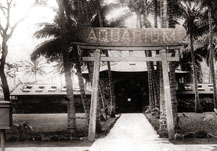A Century by the Sea
UH’s busiest visitor attraction has garnered praise and made history for 100 years in Waikiki

Waikiki Aquarium in 1921.
On March 19, 1904, a crowd gathered on Waikiki Beach to celebrate the grand opening of the Honolulu Aquarium. It was the third public aquarium to be built in the United States and one of only a dozen worldwide at the time.
Noted lawyer and U.S. presidential candidate William Jennings Bryan enthused, "No visitor to Honolulu should fail to see the aquarium." Author Jack London called it a "wonderful orgy of color and form" from which he had to tear himself away after each visit. More recent visitors, including Japan’s Crown Prince Akihito (now emperor) and actors Christian Slater and John Travolta, have been equally impressed. The Lord of the Rings Sean Astin called it "cool."
The aquarium was the brainchild of Honolulu Rapid Transit Company Director Charles M. Cooke, who contributed $8,000 of its $12,800 cost. It was originally conceived as a Kapi'olani Park attraction and trolley stop that would lure riders to the "suburbs," as Waikiki was then known.

Waikiki Aquarium today.
Renamed the Waikiki Aquarium following its reconstruction in 1955, this ocean observatory still draws both tourists and residents. With 329,000 visitors, the aquarium was 12th on the Pacific Business News 2003 ranking of Hawai'i visitor attractions, ahead of Sea Life Park, the U.S.S. Bowfin Submarine Museum and 13 other attractions.
Visitors are wowed by such seagoing inhabitants as archerfish that spit water to catch bugs, a whip-tailed zebra shark, piranha from the Amazon (donated by Hawai‘i authorities who confiscated the illegal imports), cat’s-eye and bubble corals, sea dragons, venomous scorpionfish that camouflage themselves as rocks and pulsating sea jellies so clear you can see what they’ve been eating. And that’s just a sampling of the 420 species of aquatic animals and plants on display.
Throughout its history, the aquarium has aimed at excellence in both research and exhibitry. "We can’t be as big as aquariums on the mainland," says former Director Bruce Carlson, "but we’ve done things they couldn’t do."

Giant Clam at the Waikiki Aquarium.
A West Coast researcher insisted that no one could keep giant clams alive in an aquarium; Carlson proved him wrong, nurturing several—the largest now 170 pounds and 26 years old. "We were the first aquarium in the U.S. to hatch a nautilus embryo and to grow coral," Carlson notes.
Such achievements have earned respect and accolades from aquarium organizations worldwide, including two recent MACE Award grants for conservation education excellence in aquatic exhibits and two Edward H. Bean Awards, one for pioneering methods of growing live corals and sharing more than 2,600 coral cuttings with other facilities and the other for research on the chambered nautilus, which scientists call a living fossil.
There have also been a few surprises, such as a hijacked crocodile (retrieved a few hours later when it washed up on Waikiki Beach) and what staffers call the coral wars.
"By day the brain coral has no visible tentacles," recalls former Director of Education Carol Hopper, "but during one of the popular aquarium after dark classes, we saw six-inch sweeper tentacles come out and kill other corals that had encroached into its growth space." Carlson rearranged the tank to give the killer brain coral more room.
Besides the coral battles, the aquarium has survived two World Wars and the Gulf Wars, the Great Depression, Hawai'i recessions and other societal upheavals. Crowds are expected to gather in Waikiki once again to celebrate as the aquarium enters its second century.
Historical Highlights
- 1904 The aquarium opens March 19 with 35 exhibits and 400 marine organisms. Potter’s angelfish is named for Director Frederick Potter, a former Honolulu Rapid Transit Company clerk.
- 1912 C. M. Cooke Estate funds a marine biology laboratory, launching the aquarium’s research tradition under the islands’ first professionally trained zoologist, Charles Edmondson.
- 1919 The aquarium becomes part of the University of Hawai'i.
- 1940 Zoologist and author Spencer Tinker is appointed director. He is the namesake of Tinker’s butterflyfish.
- 1955 The new facility opens 100 yards from the original site.
- 1975 Ichthyologist Leighton Taylor becomes director. He develops the first exhibits master plan and launches the aquarium’s education department, volunteer program and friends group. Taylor’s goby fish is named for him.
- 1990 Bruce Carlson is named director. He focuses on naturalistic exhibits featuring aquatic life and habitats of Hawai'i and the western Pacific. Carlson’s damselfish is named for him.
- 2000 Coastal America Partnership names the aquarium a Coastal Ecosystem Learning Center.
- 2004 Appointment of the fifth director is pending at press time.